Consumer Reports makes case for Windows 7 PCs
May be smarter to search for new PC with older OS rather than deal with Windows 8
Windows 7 may be the better choice as a PC operating system on new systems than the just-released Windows 8, Consumer Reports magazine said this week.
Why, when and how to migrate to Windows 8
“Windows 7 generally received favorable reviews when it was released,” Consumer Reports’ Donna Tapellini said in a piece Tuesday on the consumer watchdog’s website. “[Three years] after its 2009 launch, there still haven’t been a lot of complaints. If you’ve been happy with Windows 7 and even Windows XP up until now, there’s no compelling reason to switch to Windows 8.”
Consumer Reports does not evaluate and rate operating systems, as it does, say, clothes washers, cars or even computers. Instead, it staked out its position this fall when it praised Windows 8 as great for tablets, but because of its split personality, not for everyone.
Tapellini argued that several factors make Windows 7 a better choice for some consumers even two months after it was superseded by Windows 8.
Since Microsoft devoted so much time and resources building touch and gesture support into Windows 8, it makes little sense to opt for the OS unless the new PC offers a touch-sensitive screen, Tapellini said.
Others have pointed out that while Windows 8 doesn’t demand touch, it’s a tough sell without it. Many consumers have already figured that out. Earlier this month, for instance, research firm NPD Group said its retail tracking showed touch-sensitive PCs selling best among Windows 8 machines, even though their prices were higher and they were in short supply.
Tapellini also pointed out that Consumer Reports’ testing had found that some Windows 8 systems performed poorly, something she attributed to driver issues.
Although Windows 7 PCs have largely disappeared from brick-and-mortar retail chains like Best Buy, they can still be found at many e-tailers and direct from some computer makers, Tapellini said.
Consumer Reports’ highest-ranking Windows notebook, the Windows 7-powered Samsung NP900X3C-A01US Ultrabook, for example, is still available through Amazon.com for $1,139. The Samsung’s rating of 82 (out of a possible 100), puts it above Apple’s highest-rated laptop, the 15-in MacBook Pro with a Retina screen and Consumer Reports’ top-rated Windows 8 portable, the Dell XPS 12 Convertible Touch Ultrabook. Dell’s hybrid — part tablet, part notebook — earned a 75; the MacBook Pro pulled 78.
Microsoft will allow OEMs (original equipment manufacturers) to sell Windows 7-equipped PCs until October 2014, two years after Windows 8’s launch, so there’s no immediate danger of the older operating system vanishing.
In fact, most enterprises will continue to migrate from the 11-year-old Windows XP, which will be retired in April 2014, to Windows 7 rather than bet on Windows 8, research firms have predicted.
Buyers who take Consumer Reports’ advice, in other words, will have plenty of company.
Best Microsoft MCTS Certification,
Microsoft MCITP Training at certkingdom.com


